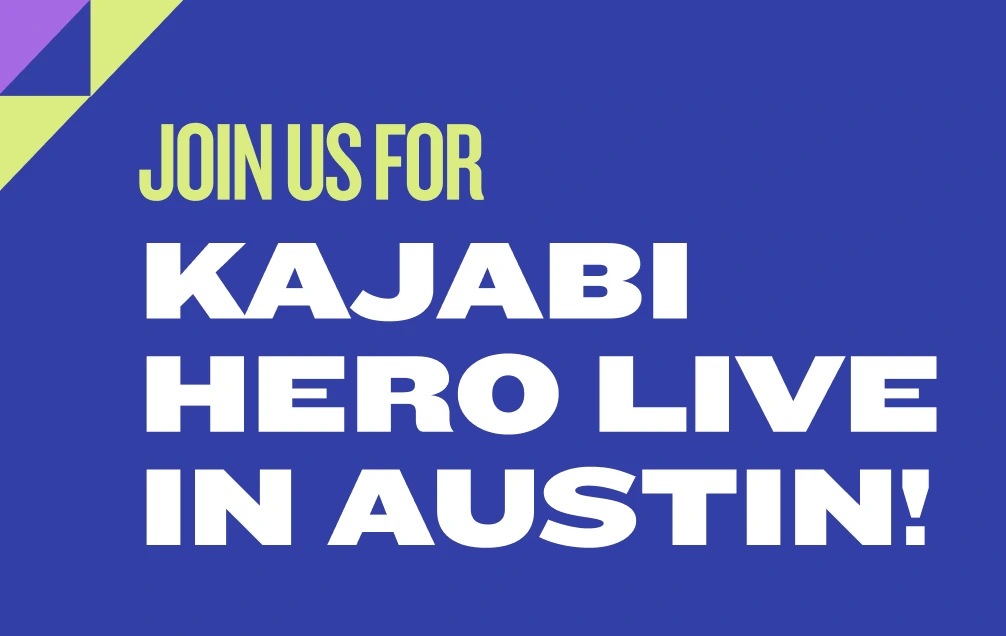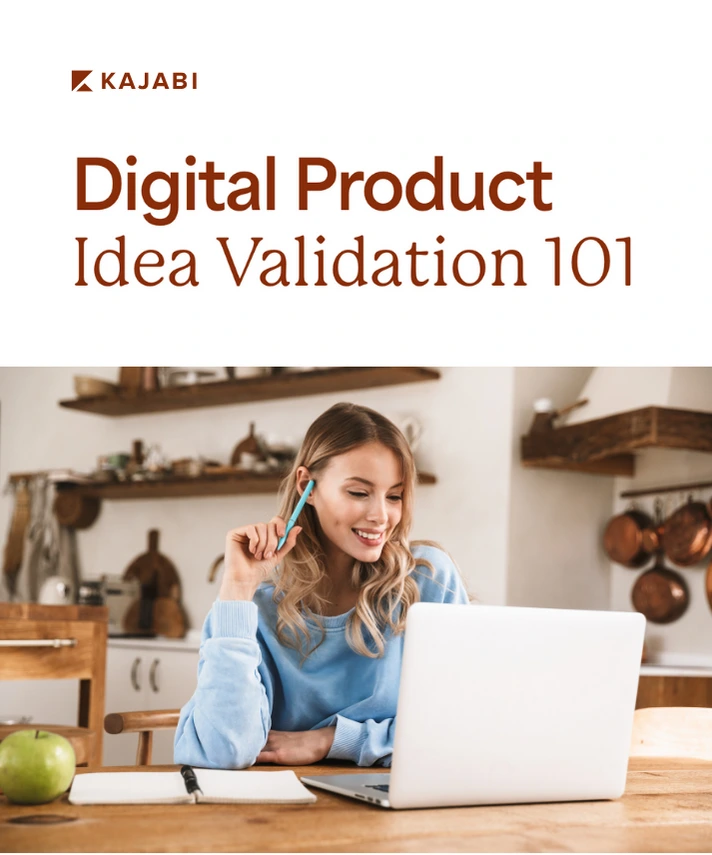
Content marketing: what is it, plus benefits, types and examples
Get free expert insights and tips to grow your knowledge business sent right to your inbox.
If you’re new to content marketing, we’ve got you covered. It’s not as difficult or as time-consuming as it sounds, but it does require a bit of knowledge.
Fortunately, you’re in the Knowledge Commerce business.
As you create digital products for your customers, you’ll need a way to market them. Content marketing is the best strategy we’ve found to not only reach your audience, but convert them into customers.
Whether you’re promoting your new online course or a membership site, you can drive people to do those products and convince them to buy. Content marketing serves as the magnet that attracts them as well as the persuasion to get them to convert.
It’s all part of the pipeline. But what is content? What is content marketing? And, most importantly, how can you use content marketing to your advantage? Let’s dive into the details.
What Is Content?

Content consists of any information that other people can consume. It's designed to educate, entertain, or persuade an audience.
We often think of content as articles and blog posts. However, marketers have discovered myriad other ways to connect with their target customers.
For instance, you might get better traction by producing video content or launching a podcast. The important thing is to make it consumable. If others can't view, hear, or read your content, it can't serve its purpose.
Keep in mind that content isn't just words on a page (or images or audio content). It must serve a valuable purpose. Your audience should walk away smarter, more entertained, or more inspired than before they consumed it.
What Is Content Marketing?
To define content marketing, let’s turn to the foremost authority on the subject, the Content Marketing Institute. According to the organization, there’s a very clear definition of content marketing:
“Content marketing is a strategic marketing approach focused on creating and distributing valuable, relevant, and consistent content to attract and retain a clearly defined audience — and, ultimately, to drive profitable customer action.”
So let’s break down this definition a little further so you can use it to your advantage.
Strategic Marketing Approach
When it talks about a strategic marketing approach, the CMI means that content marketing should serve a larger purpose. In other words, you don’t write articles just because. You write them because they fit with your other marketing efforts.
When you begin content marketing, consider your strategy in light of the rest of your marketing campaign. Weave content into social sharing, email marketing, and everything else.
Create and Distribute Valuable, Relevant, and Consistent Content
The CMI actually says quite a bit with just a few words here. The message we want you to take away from it is this: Content needs to have certain qualities.
- Valuable: What problem does the content help the reader solve? What pain point does it help resolve? How can the reader use your content to achieve a goal
- Relevant: Why should your audience care about this piece of content? What’s the takeaway? How does it fit into their personal or professional lives?
- Consistent: How often do you post new content? How long is each piece? What types of topics do you cover? And are all of these facets consistent?
Attract and Retain a Clearly Defined Audience
“Your goal with content marketing isn’t to convince everyone and his dog to read your content. Instead, you want to attract and keep people who are interested in your digital products and likely to become customers. #Kajabi” — Tweet this!
You can attract people to your content through solid SEO, social shares, and email marketing. Retain them by consistently delivering on your promises and providing value.
Most importantly, though, know your audience. You want those specific people to consume your content.
Drive Profitable Consumer Action
You’re not in business just because you’re bored, right? It’s not a charitable cause.
You want to make money.
Consequently, your content marketing should ultimately help people (your target audience) make the decision to buy your products.
You’re driving profitable consumer action by illustrating your products as the solution to a problem, the way to reach a goal, or the salve for a pain point.
How Does Content Marketing Work?

Content marketing doesn’t have to be difficult, but it does require a strategy. Anyone can type up an article and throw it on a blog, but that’s usually a waste of time.
You can make content marketing work for you by creating goals for your marketing campaigns and using your content to help achieve them. Your goals could be any number of things:
- Attract X% more customers
- Generate X% more revenue
- Bring in X% more leads
- Drive traffic through social media
- Build your brand
Once you’ve set your goal, you create content that aligns with your goals.
Let’s say that you want to generate more leads. You’re looking for people at the top of the sales funnel — consumers who aren’t brand aware, but who might need your digital products.
At this stage, you need your content to educate. Pack as much value as possible into every article you write, then use a CTA to send traffic to your email newsletter signup form.
It can work like this for any goal and any strategy. You’re creating content that ultimately brings more customers to your virtual door and convinces them to walk through it.
What Are the Benefits of Content Marketing?
It’s all well and good to define content and content marketing and to understand how it works. But why should you put forth the effort?
We can categorize the benefits of content marketing into four different areas: awareness, research, consideration, and buy.
Awareness
The awareness stage is the top of the sales funnel. At this time, the consumer doesn’t even know what he or she is looking for. The consumer might stumble across your content while performing a simple Google search or scanning hashtags on social media.
Your job at this stage is to simply introduce your brand and your product. There’s no hard sell, no asking the consumer to buy — just creating awareness.
Your content should say, “This is my blog. I write about topics X, Y, and Z. Feel free to explore.”
The goal here is to put your brand into the consumer’s mind. When he or she decides to look into a potential purchase, you want to be top of mind.
Research
Further down the funnel, consumers start doing research. They might Google phrases like “best online courses for photography” or “best way to learn about DSLRs.” In other words, they’re comparing their options.
At this stage, you want to capture their research and guide them to your article. Publishing comparison-style pieces as well as articles about what to look for in an online course about your topic can perform well.
But it can’t be promotional. Consumers aren’t looking for a sales pitch — they want hard data that will help them make an informed decision.
You might even recommend a competitor in certain instances. After all, we can’t be everything to everyone, and there might be certain instances in which another Knowledge Commerce professional’s product would better suit the reader.
That’s fine. Be as objective and thorough as possible.
Consideration
Content for the consideration stage should present your digital products as the ideal solution for the consumer. He or she has already done the research. Now you need to set the hook.
Consideration is different from research because the consumer is actually weighing a buying decision. He or she knows about the available products, but has yet to choose the best one.
You have a golden opportunity here. Your content should establish your credibility in the field, show your generosity, and provide as much value as possible. Show that you’re willing to give away your secrets for free. The consumer will wonder what amazing value you provide in your paid products.
Buy
The buying stage of the customer journey is the point of no return. Your prospect has decided to buy a product and is next in line to buy yours.
Lots of things can get in the way of that. A long, drawn-out checkout process, for instance, can give a buyer second thoughts. So can poorly written sales copy, a confusing landing page, or a murky CTA.
Your job here is to persuade. You want the consumer to buy your online course — not someone else’s. Use your copywriting skills to distinguish your product as the ideal solution for the consumer.
Why Is Marketing Impossible Without Great Content?
The business world is simultaneously brimming with opportunity and cluttered with competition. You can build any business you want, but you have to find a way to stand out.
Content marketing is the only solution. It’s how you differentiate yourself from the competition.
In fact, in Knowledge Commerce, it’s even more important. People buy your online courses and subscribe to your membership site because they value the information you share.
If they don’t know how educated, talented, and skilled you are, how can they put their faith in you?
They can’t. Content marketing allows you to demonstrate your expertise and wow your audience from the get-go.
Plus, you can’t get customers if you can’t get found. SEO-optimized articles allow you to rank higher in the Google SERPs, which gives you more access to your audience.
When someone searches for a keyword related to what you do, you want them to find your site. You can’t rely on a homepage, an about page, and a contact page to do that. Content marketing puts more pages on the web, which helps you increase your chances of attracting traffic.
What Are the Differences Between Content Marketing and Traditional Marketing
Content marketing is, in some ways, rooted in traditional content. Think about the days before the Internet.
You might have gotten information from leaflets, pamphlets, brochures, and full-page magazine ads. All of these documents served to help educate you — the consumer.
But these days, content marketing is far more prevalent. It’s also easier to create and consume.
You don’t need an industrial-quality printer or a professional graphic designer on your team to distribute content. Instead, you set up a Kajabi blog in minutes and start sharing your knowledge.
Content marketing is also different from traditional marketing in that it’s not all about sales. In fact, most articles and blog posts don’t mention buying at all.
Instead, they’re all about education. They help consumers make smart, educated decisions based on what they’re interested in buying.
They might even teach skills or knowledge without assuming the consumer will buy anything at all. Generosity with knowledge is a cornerstone of the modern business.
10 Types Of Content Marketing
You understand content and content marketing. You get why they’re important and how they work. But what types of content should you publish?
Many entrepreneurs, when they hear the phrase “content marketing,” automatically think of blog posts. Those are undeniably a big part of content marketing.
But lots of other types of content exists. Let’s explore 10 of them now so you can start creating and attracting more consumers to your digital products.
1. Infographics
Believe it or not, infographics are among the most-shared content types in the world. Why? They’re highly visual and they make data easy to consume.
If you’re targeting consumers at the top of the funnel, creating infographics can help lead them to your site. Additionally, the value you provide can convert first-time visitors into long-term customers.
The important thing is to leverage infographics as much as possible:
- Post the infographic as its own blog post with a detailed description below. If possible, include an embed code for people who might want to share it.
- Upload the infographic to websites like Visual.ly, which help distribute infographics and encourage sharing.
- Add screenshots of portions of your infographic to other blog posts. Link to the original for SEO (interlinking between posts) and to convince people to spend more time on your site.
- Share your infographics on social media. Use a screenshot of a portion of it or share the whole thing.
- Encourage people to share the infographic with their own audiences.
With these strategies, you can see how infographics can draw serious traffic to your site. Not only that, but they’re likely to draw qualified, interested traffic. That makes a huge difference.
2. Blog Posts

You knew we were going to mention blog posts here, right? Blogs are, in some ways, the definition of content marketing.
A blog provides you with a unique space in which to share your content. It belongs to you, so you’re not beholden by anyone else’s rules.
Through SEO optimization, social media sharing, and email marketing, your blog posts can get tons of traction. You just have to focus on targeting the right keywords, understanding your buyer personas, and targeting consumers at the right points in the sales funnel.
3. Podcasts
Think of podcasts as the audio versions of blog posts. The main difference is that they’re often longer and more detailed.
They also give you the chance to show off your personality in a more intimate way.
Podcasters create audio files that last anywhere from 10 minutes to more than two hours, depending on the content discussed and the speaker’s preferred format. You can experiment with different deliveries to see what works best for your audience.
Ideally, a podcast should entertain as well as educate. You want people to listen because they’re engaged with your voice, energy, and enthusiasm.
4. Videos
If you want to take content marketing a step further than podcasts, create videos. We encourage our customers to use video for their online courses. Consequently, it makes sense to use video for marketing purposes.
A video puts you front-and-center before your audience. You can exhibit your teaching style and your manner of communication so potential customers know whether or not your voice and style resonate with them.
Video is also good training for your online courses. The more comfortable you become in front of the camera, the more natural you seem when delivering your course content.
5. E-books
While e-books are better for some industries than others, they’re incredibly valuable in Knowledge Commerce. People love long-form content because they don’t have to seek out information from multiple sources.
Plus, e-books make great lead magnets. Prospects can download your e-book for free, but first they have to part with their contact information. That way, you can target them with email marketing and weave them into the fabric of your brand.
You can also create e-books for sale as part of your digital product backlist. An e-book establishes you as a published author and gives you instant credibility. However, you have to tone down the marketing if you want people to buy your book. For persuasion, free e-books work far more effectively.
6. Whitepapers and Reports
Speaking of lead magnets, you can also create whitepapers and reports for your audience. Whitepapers are a bit more technical than e-books. They break down science, math, theories, and other interesting information for public consumption.
Meanwhile, reports deliver data in easy-to-consume chunks. You can even use the data from a report to create an infographic. That way, you get two pieces of content marketing with the same information.
Some people like to read reports. They want all the details. Others prefer infographics because they want a broad overview of the topic. When you create both, you give your audience options.
7. Case Studies
We love case studies here at Kajabi. In fact, we often create them for our Kajabi Heroes. Why? It’s great marketing, but it also celebrates our customers and their successes.
You can use independent case studies created by other professionals or establish your own case studies. Either way, the data can help your potential and existing customers make informed decisions.
Case studies often attract attention because they highlight someone’s amazing success. They’re inherently motivational and uplifting, which can spell success for your business, too.
8. Webinars
If you want to connect with your audience in an intimate way without calling them on the phone, host a webinar. You can talk with dozens or even hundreds of people at the same time.
Both live and pre-recorded webinars offer the same benefits as traditional video, but with the added bonus of interaction. You can also ask people to register for the webinar and provide a discount code for people who participate.
In other words, they’re a powerful marketing tool.
The best webinars offer tons of value while allowing the host to communicate with participants. People can ask questions in the chat portion of the webinar, then you can answer them.
9. Email Marketing
We’ve talked a lot about email marketing here on the Kajabi blog — and for good reason. Email allows you to keep in touch with your subscribers and continually whisper your brand name in their ears.
Sure, some people don’t open promotional emails. You might get unsubscriptions and poor click-through rates.
But that’s not the point. Email marketing involves creating a single email for all of your subscribers. In other words, you can get amazing benefits with minimal effort.
Let’s say that you write an email that lists your latest blog posts. You have 500 subscribers and three buy your latest online course for $99.
You might have spent 30 minutes or so on the email. In exchange, you pocketed nearly $300. That’s a pretty spectacular return-on-investment.
10. Calculators and Tools
The last type of content is relatively difficult to create in comparison to the others, but it can also yield amazing results. Calculators and tools provide immense value in a small space.
Financial website Bankrate, for instance, offers free financial calculators:

You can use this one to determine your mortgage payment based on a few numbers.
Similarly, Ubersuggest.io allows you to conduct keyword research for free:

You just type in a keyword and get hundreds of suggestions on which to base future content.
Tools and calculators are great for driving traffic and delivering value. However, you also want to have text on the page.
Give people a basic understanding of how your calculator or tool works. Use keywords related to your digital products so you can later interlink them.
Why Does SEO Matter for Content Marketing?

When it comes to content marketing, SEO (search engine optimization) is perhaps the most important factor in your success. It determines whether or not you show up in the search engines for a relevant keyword.
You can optimize your content for SEO in numerous ways:
- Use primary and related keywords throughout the content.
- Include your primary keyword in the title tag as well as at least one subheading.
- Optimize your image ALT tags with your keyword and relevant text.
- Create a meta-description that includes the primary keyword as well as persuasive text.
- Interlink your articles and other pieces of content.
- Get backlinks from high-authority sites via email outreach, guest blogging, and other strategies.
SEO takes time to master, but it’s worth the effort. When you rank high in the SERPs, you get tons of traffic from people who are interested in your digital products.
What Are Some Great Content Marketing Examples?
If you’re interested in content marketing, you probably want to know who’s doing it right. What businesses and entrepreneurs consistently churn out great content for their audiences?
Let’s start with one of the most well-known entrepreneurs: Gary Vaynerchuk (also known as Gary Vee). He creates articles, books, podcasts, videos, and tons of other content for his audience.
As a result, he shows up in the search engines and runs a multi-million-dollar business.
You could say the same for Neil Patel. He’s a content marketer, digital marketer, and traffic-generating genius. His content appears all over the web, and he’s created a brand around his trademark generosity and willingness to share his knowledge.
But what about the Knowledge Commerce industry? Check out researcher and storyteller Brene Brown. She gave a TED talk that brought in millions of views several years ago, and since then, she’s published numerous books and launched several companies.
All of these content marketers have a few things in common:
- They’re generous with their knowledge and expertise.
- Each provides several different ways to consume content, from text to video.
- They take the time to interact with their audiences.
- Each has products they sell behind their brands.
Content marketing production framework
Now that you're caught up to speed on content marketing, you could use a framework to help you streamline your content production process. Borrow one from Justin Welsh. He's built up a Twitter audience of over 176,000 followers and an email list of over 45,000 subscribers:
Conclusion
Content is one of the most powerful things on the Internet. It’s information dispensed through a specific medium to educate, entertain, or inform your audience.
Content marketing takes it a step further. It not only educates and informs, but it helps you bring more customers to your business. In effect, it’s designed to drive revenue as well as traffic and leads.
Traditional marketing has nothing on content marketing. You need content if you want to remain relevant in the online space.
So what types of content can you create?
Share infographics, write blog posts, produce podcasts, and record videos. Consider using e-books, white papers, and reports as lead magnets.
We also recommend creating case studies and webinars. And, to keep in touch with your target audience, make sure you’re running a robust email marketing campaign.
If your industry supports it, consider creating a calculator or tool. These high-value deliverables make attracting new prospects a breeze.
Use Kajabi To Turn Your Knowledge And Content Into Products You Can Sell
You’re all set to create your own content marketing campaign, but where do you start? Fortunately, Kajabi offers all of the tools you need to create a content marketing machine and to promote your digital products ethically and effectively.
For instance, it only takes a few steps to set up a Kajabi blog. Just choose a template, write a welcome blog post, and begin connecting with your audience.
You can also create landing pages, sales pages, and email marketing campaigns. Best of all, you don’t need any third-party tools to help you along the way, which saves you time and money.
There’s no reason to hesitate when it comes to earning money from your knowledge. In fact, now is the best time to get started. We’re so convinced of your success that we’re offering a 14-day free trial so you can get your feet wet. What’s stopping you?
Find more blog posts by category:













